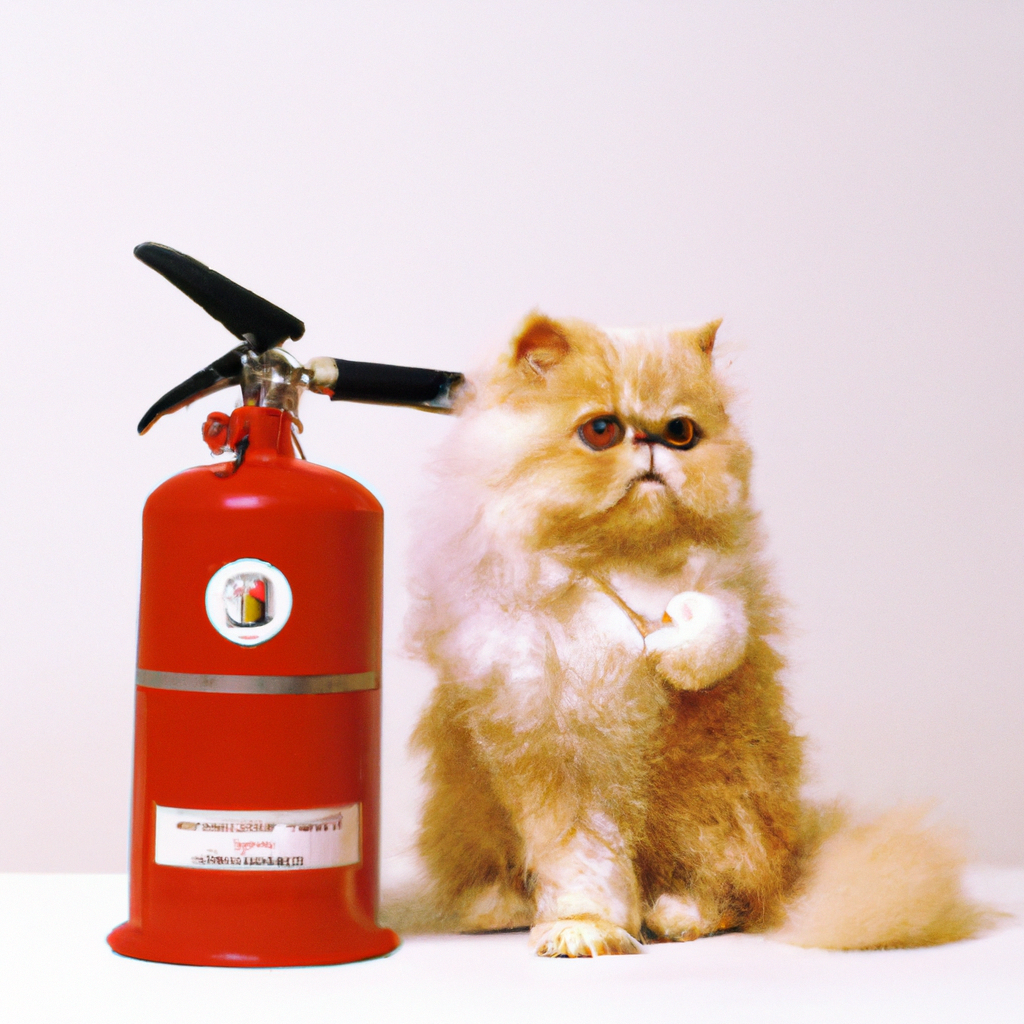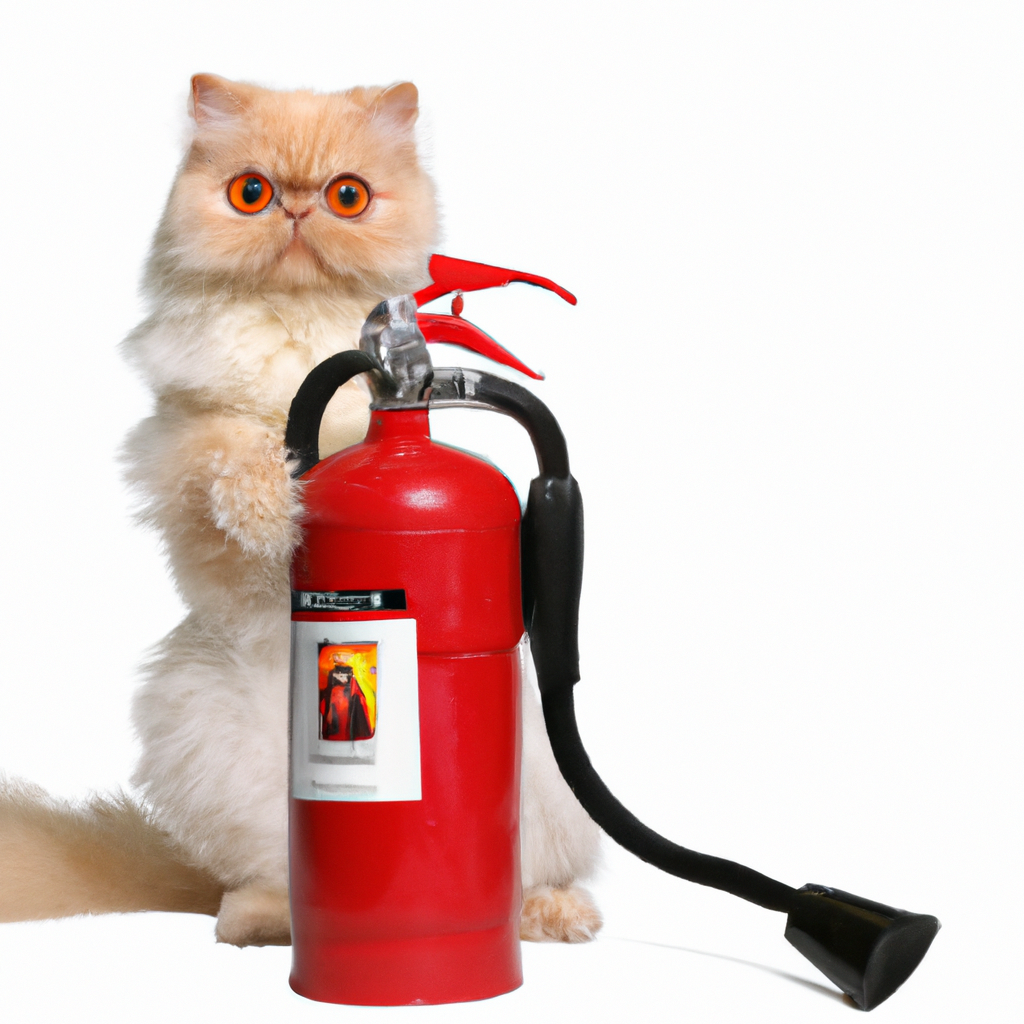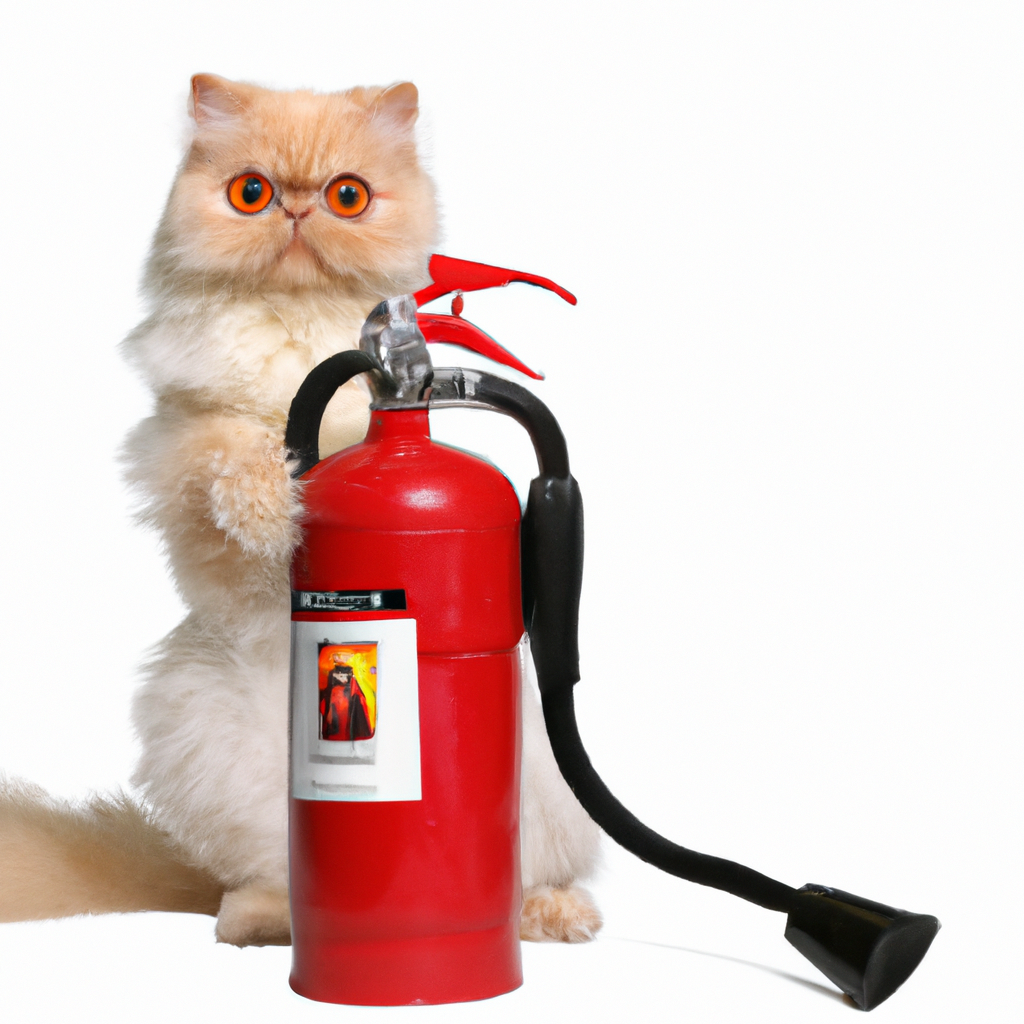Persian Cats and Fire Safety: Precautions to Keep Them Protected. As a persian cat owner, it’s important to ensure the safety and well-being of your furry friend. One area that requires particular attention is fire safety. Persian cats have long, fluffy fur that can easily catch fire, and their curious nature may lead them into dangerous situations. This article will provide you with valuable tips and precautions to protect your beloved pet from the dangers of fire. From checking your smoke alarms regularly to keeping candles out of reach, we’ll cover everything you need to know to keep your persian cat safe and sound. So, let’s dive in and learn how to protect our feline friends from potential fire hazards!

Fire Hazards in the Home
Fire hazards in the home are potential dangers that can lead to fires if not properly addressed and prevented. It is crucial to identify these hazards in order to ensure the safety of your home and loved ones. By being aware of the common causes of fires in homes and implementing fire safety measures, you can significantly reduce the risk of fire incidents.
Identifying Potential Fire Hazards
To effectively prevent fires, it is important to be able to identify potential fire hazards in your home. Some common fire hazards include:
-
Electrical appliances and wiring: Faulty or outdated wiring, overloaded electrical outlets, and malfunctioning appliances can all pose a fire risk.
-
Cooking equipment: Unattended cooking, grease buildup, and flammable materials near stovetops can easily lead to kitchen fires.
-
Heating sources: Fireplaces, space heaters, and furnaces should be properly maintained and checked regularly to prevent any potential fire hazards.
-
Flammable materials: Candles, cleaning products, and other flammable substances should be stored safely and away from heat sources.
Common Causes of Fires in Homes
Fires in homes can be caused by various factors. Some common causes include:
-
Cooking accidents: Unattended cooking, grease fires, and flammable items near the stove are frequent causes of house fires.
-
Heating equipment malfunction: Faulty heating systems, space heaters, and fireplaces can lead to fires if not properly maintained.
-
Electrical malfunctions: Outdated wiring, overloaded circuits, and faulty electrical appliances are common causes of electrical fires.
-
Carelessness with smoking materials: Improperly extinguished cigarettes or smoking materials can easily ignite fires, especially if in contact with flammable materials.
Importance of Fire Safety Measures
Implementing fire safety measures in your home is crucial for the safety of yourself, your loved ones, and your property. These measures can significantly reduce the risk of fire incidents and minimize potential damage. Some key reasons why fire safety measures are important include:
-
Protection of lives: Fire safety measures such as smoke detectors and fire alarms provide early warnings, giving occupants valuable time to evacuate safely.
-
Property preservation: By preventing fires or detecting them early, fire safety measures can help minimize damage to your property.
-
Peace of mind: Knowing that you have taken necessary precautions to protect your home and loved ones can give you peace of mind and reduce anxiety about fire hazards.
-
Compliance with regulations: Adhering to fire safety regulations and guidelines ensures that your home meets the necessary standards for safety.
By understanding the potential fire hazards in your home, being aware of common causes of fires, and implementing fire safety measures, you can create a secure and fire-safe environment for yourself and your family.
Understanding Persian Cats
Persian cats are a popular breed known for their luxurious appearance and calm demeanor. By gaining a deeper understanding of Persian cats, including their history, physical characteristics, and behavioral traits, you can better care for these unique feline companions.
Brief History of Persian Cats
Persian cats have a rich history dating back to ancient times. They are believed to have originated in Persia (now Iran) and were highly prized by royalty and aristocracy for their beauty. These cats eventually made their way to Europe and gained popularity among cat enthusiasts worldwide. Today, Persians are one of the most popular cat breeds globally.
Physical Characteristics of Persian Cats
One of the defining features of Persian cats is their long and flowing coat. Their fur requires regular grooming to prevent matting and keep it in pristine condition. Persian cats have a distinct round face with large, expressive eyes, a short nose, and small ears. They come in various colors, including solid, tabby, tortoiseshell, and colorpoint patterns.
Behavioral Traits of Persian Cats
Persian cats are known for their gentle and laid-back nature. They are typically calm, quiet, and enjoy a relaxed and predictable lifestyle. Due to their independent nature, Persian cats may not be as active or outgoing as some other breeds. They are often content with quiet indoor environments and prefer cozy spots for lounging and observing their surroundings.
It is important to provide Persian cats with a calm and stress-free environment as they can be sensitive to loud noises or sudden changes. Adequate socialization and regular playtime can help keep them mentally and physically stimulated.
Unique Vulnerabilities of Persian Cats
While Persian cats are loved for their stunning appearance and gentle temperament, they do possess some unique vulnerabilities when it comes to fire safety. It is essential for Persian cat owners to be aware of these vulnerabilities and take specific precautions to ensure the safety and well-being of their feline companions.
Anatomy and Respiratory Susceptibility
Persian cats have a unique facial structure characterized by their short nose and flat face, known as brachycephaly. This anatomy can make them more susceptible to respiratory issues and breathing difficulties, especially in stressful situations such as fires. The constricted airways of Persian cats require special attention during fire incidents to prevent respiratory distress.
Long Fur and Flammability
The long and dense coat of Persian cats can be a fire hazard if not properly maintained. Their fur is highly flammable and can quickly ignite if in contact with flames or sparks. Additionally, the fur can trap smoke and toxic fumes, further endangering the cat’s respiratory system. Regular grooming and keeping the fur clean and free of mats can help reduce the risk of fur-related fire accidents.
Behavioral Responses to Fire
In the event of a fire, Persian cats may exhibit unique behavioral responses. They may become fearful, hide, or try to escape the immediate area. It is important for cat owners to understand their cat’s behavior and be prepared to locate and evacuate them safely during emergencies. Providing a designated safe area for the cat to retreat to can also help alleviate stress during fire incidents.
Fire Safety Precautions for Persian Cat Owners
As a Persian cat owner, it is crucial to take specific fire safety precautions to protect your cat and ensure their well-being in case of emergencies. By creating a secure environment, installing smoke detectors and fire alarms, and practicing proper electrical wiring and appliance usage, you can significantly reduce the risk of fire incidents within your home.
Creating a Secure Environment
Ensure that your home is free from potential fire hazards by:
- Keeping clutter to a minimum to prevent the accumulation of flammable materials.
- Storing chemicals, cleaning products, and other hazardous substances in secure and designated areas.
- Securing loose wires and cables to prevent cats from chewing on them or causing electrical hazards.
Installing Smoke Detectors and Fire Alarms
Early detection of fires is crucial for the safety of your cat and your household. Install smoke detectors and fire alarms in strategic locations throughout your home, including near sleeping areas and common rooms. Regularly test these devices to ensure they are working properly and replace batteries as needed.
Proper Electrical Wiring and Appliance Usage
Faulty wiring and unsafe electrical practices can lead to fire incidents. To minimize the risk:
- Have a professional inspect your home’s electrical system regularly and address any issues promptly.
- Avoid overloading electrical outlets and use power strips with surge protectors as needed.
- Unplug electrical appliances when not in use and avoid leaving them on when you are away from home.
By implementing these fire safety precautions in your home, you can create a safer environment for your Persian cat and reduce the risk of fire incidents.

Charting Escape Routes and Safe Areas
In the event of a fire, it is vital to have well-defined escape routes and designated safe areas for both humans and pets. By identifying primary and secondary escape routes, designating a safe area, and training your Persian cat for evacuation procedures, you can enhance everyone’s chances of safely navigating through emergencies.
Identifying Primary and Secondary Escape Routes
Familiarize yourself with the layout of your home and identify primary and secondary escape routes. Ensure that these routes are easily accessible and free from obstacles. Consider multiple evacuation options, such as windows or alternate exits, in case certain routes become blocked during a fire.
Designating a Safe Area During Emergencies
Select a safe area within your home where you can gather with your Persian cat during a fire. This area should be a room or space that is easily accessible and away from any potential fire hazards. Ensure that the safe area has a door or window for emergency exit and is equipped with necessary supplies, such as food, water, and a carrier for your cat.
Training Cats for Evacuation Procedures
Persian cats can be trained to respond appropriately during fire incidents, increasing their chances of survival. Familiarize your cat with the sound of smoke alarms and practice evacuation drills regularly. Use treats and positive reinforcement to encourage your cat to come to you when called and enter their carrier for safe transportation.
Fire Safety Equipment for Persian Cats
Equipping your home with essential fire safety equipment is crucial for the well-being of your Persian cat. By having fire extinguishers, emergency evacuation kits, and protective gear for cat owners readily available, you can effectively respond to fire incidents and ensure the safety of both humans and pets.
Fire Extinguishers and Their Usage
Place fire extinguishers in strategic locations throughout your home, such as the kitchen, garage, and near potential fire hazards. Learn how to properly use a fire extinguisher and familiarize yourself with the types of fires they are suitable for. Remember, the safety of yourself and your cat should always be the priority, so only attempt to extinguish small, manageable fires.
Emergency Evacuation Kits for Cats
Prepare an emergency evacuation kit specifically for your Persian cat. This kit should include essential items such as:
- An extra leash and collar.
- Food and water supplies for at least three days.
- Medications and necessary prescription information.
- A copy of your cat’s medical records and vaccination history.
- Comfort items, such as a favorite blanket or toy.
Store the kit in an easily accessible location and update it regularly to ensure that all supplies are fresh and current.
Protective Gear for Cat Owners
During a fire incident, it is vital to protect yourself while evacuating your Persian cat. Equip yourself with the following protective gear:
- Sturdy gloves to protect your hands from potential hazards.
- A face mask or cloth to protect against smoke and toxic fumes.
- A long-sleeved shirt and pants to cover exposed skin.
By having these fire safety equipment and gear readily available, you can better respond to emergencies and ensure the safety of both yourself and your Persian cat.
Preventive Measures for Fire-Prone Areas
Certain areas of the home are more prone to fires than others. By implementing specific fire safety precautions in the kitchen, bedroom, and living room, you can minimize fire risks and create a safer environment for your Persian cat.
Fire Safety Precautions for the Kitchen
The kitchen is a high-risk area for fires due to cooking activities. Reduce the risk by:
- Never leaving cooking unattended, especially when using the stove or oven.
- Keeping flammable materials, such as curtains or paper towels, away from heat sources.
- Regularly cleaning kitchen appliances, particularly the stovetop and oven, to prevent grease buildup.
Minimizing Fire Risks in the Bedroom
Bedrooms can be susceptible to fires caused by electrical hazards. Take precautions by:
- Avoiding the use of extension cords and instead using properly installed electrical outlets.
- Checking electrical blankets and heating pads for any signs of wear or damage before use.
- Keeping candles, smoking materials, and other fire hazards out of the bedroom.
Safety Measures for the Living Room
The living room is often a gathering place with various electronic devices, making it important to:
- Regularly inspect and maintain electrical cords and outlets to prevent potential fire hazards.
- Avoid overloading electrical outlets with too many devices or power strips.
- Keep flammable materials, such as curtains or furniture, away from heaters or open flames.
By implementing these preventive measures in fire-prone areas, you can significantly reduce the risk of fires in your home and increase the safety of your Persian cat.
Pet-Proofing the Home
Pet-proofing your home is essential for both the safety of your Persian cat and the prevention of potential fire hazards. By securing electrical cords and outlets, storing hazardous materials safely, and preventing access to fireplaces and candles, you can minimize the risk of fire incidents related to your cat’s behavior.
Securing Electrical Cords and Outlets
Persian cats may be curious and prone to chewing on electrical cords, posing both a fire hazard and a danger to themselves. Prevent this risk by:
- Using cord protectors or concealers to keep cords out of reach.
- Covering outlets with childproof covers to prevent cats from playing with them.
Storing Hazardous Materials Safely
Chemicals, cleaning products, and other hazardous materials should be stored safely to prevent your Persian cat from accidentally ingesting or knocking them over. Place these items in locked cabinets or high shelves that are inaccessible to your cat.
Preventing Access to Fireplaces and Candles
Fireplaces and candles can pose significant fire risks, especially when left unattended. Take precautions by:
- Using fireplace screens and keeping any flammable materials away from the hearth.
- Avoiding the use of open flames, such as candles, or using flameless alternatives instead.
By pet-proofing your home and implementing these preventive measures, you can create a safer environment for your Persian cat and minimize the risk of fire incidents.
Creating a Fire Escape Plan for Persian Cats
Developing a fire escape plan specifically tailored to the needs of your Persian cat is crucial for ensuring their safety in times of emergencies. By assigning responsibilities to family members, practicing evacuation drills, and regularly evaluating and updating the plan, you can enhance the efficiency and effectiveness of your escape strategy.
Developing an Emergency Plan
Create a detailed fire escape plan that includes:
- Primary and secondary escape routes.
- Designated safe areas for gathering.
- Specific responsibilities for each family member, including tasks related to the cat’s safety.
- Communication methods, such as predetermined meeting points or designated family members responsible for ensuring everyone’s safety.
Ensure that each family member is familiar with the plan and understands their role in executing it.
Assigning Responsibilities to Family Members
Divide responsibilities among family members to ensure the smooth execution of the fire escape plan. Assign specific tasks such as:
- Retrieving the cat carrier.
- Ensuring that all family members, including the cat, are accounted for during evacuation.
- Checking doors and windows for safe exit routes.
By clearly assigning responsibilities, everyone will have a specific role to fulfill, making the evacuation process more organized and effective.
Practice Drills and Regular Evaluations
Regularly practice evacuation drills with your family, ensuring that your Persian cat is included in these drills. Test different scenarios, such as evacuating from different rooms or during the night, to ensure that everyone is prepared and familiar with the plan. After each practice, evaluate the effectiveness of the escape plan and make any necessary adjustments or improvements.
By regularly practicing and evaluating your fire escape plan, you can increase its efficiency and effectiveness, providing the best chances of a safe evacuation for both yourself and your Persian cat.
Importance of Fire Safety Education
Raising awareness about fire risks, educating children about fire safety, and promoting responsible pet ownership are critical aspects of ensuring the safety of both humans and Persian cats. By understanding the importance of fire safety education, you can actively contribute to creating a fire-safe community.
Raising Awareness About Fire Risks
Educate yourself and others about the common causes of fires, potential fire hazards, and the importance of fire safety measures. Share this knowledge with friends, family, and neighbors, emphasizing the significance of being proactive in creating a fire-safe environment.
Educating Children About Fire Safety
Teaching children about fire safety from an early age is crucial for their well-being. Engage in age-appropriate discussions about fire hazards, escape plans, and the importance of following safety rules. Conduct interactive activities and drills to help them understand and remember essential fire safety practices.
Promoting Responsible Pet Ownership
Responsible pet ownership extends beyond meeting the basic needs of your Persian cat. It also includes taking precautions to ensure their safety, especially in situations like fires. Encourage other pet owners to learn about fire safety measures and the specific vulnerabilities of their pets.
By actively participating in fire safety education efforts, you can contribute to creating a fire-safe community, protecting both humans and Persian cats.
Conclusion
Implementing fire safety measures and understanding the unique vulnerabilities of Persian cats is of utmost importance for the well-being of both humans and feline companions. By identifying potential fire hazards, creating a secure environment, installing appropriate safety equipment, and developing a comprehensive fire escape plan, you can significantly reduce the risk of fire incidents in your home. Remember to regularly review and update your fire safety measures and stay vigilant in maintaining a fire-safe environment for your Persian cat. With proper precautions and education, you can enjoy a peaceful and fire-safe home environment while ensuring the happiness and safety of your beloved Persian companion.
